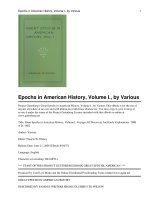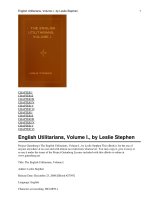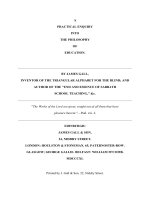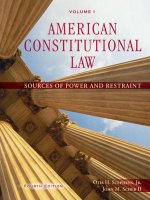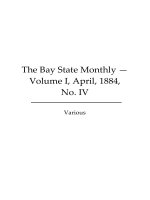ebooksclub org theophrastus enquiry into plants volume i books 1 5 loeb classical library no 70
Bạn đang xem bản rút gọn của tài liệu. Xem và tải ngay bản đầy đủ của tài liệu tại đây (14.19 MB, 522 trang )
=
CD
•'^"^hiCr
THE LOEB CLASSICAL LIBRARY
EDITED BY
APPS, Ph
D.,
LL.D.
T. E.
PAGE,
LiTT.D.
W. H. D. HOUSE, Litt.D.
THEOPHRASTUS
ENQUIRY INTO PLANTS
I
THEOPHRASTUS.
VILLA ALBANI.
THEOPHEASTUS
ENQUIRY INTO PLANTS
AND MINOR WORKS ON ODOURS AND
WEATHER SIGNS
WITH AN ENGLISH TRANSLATION BY
SIR
ARTHUR HORT,
Bart.,
M.A.
FORMERLY FELLOW OF TRINITV COLLEGE, CAMBRIlXiE
IN
TWO VOLUMES
I
LONDON WILLIAM HEINEMANN
NEW YORK G. P. PUTNAM'S SONS
:
:
MCMXVI
PREFACE
attempt at an English
'Enquiry into Plants.' That it
should be found entirely satisfactory is not to be
expected, since the translator is not, as he should be,
a botanist moreover, in the present state at least
of the text, the Greek of Theophrastus is sometimes
singularly elusive.
I should never have undertaken
such a responsibility without the encouragement of
This
is^ I
believe, tlie first
of the
translation
;
Canon
EUacombe, who first suggested that I should make
the attempt and introduced me to the book.
It is a
that veteran student of plant-lore the Rev.
great grief that he did not live to see the completion
of the work which he set me.
it
essential that a translator of
If I had thought
Theophrastus should
himself grapple with the difficulties of identifying
the jilants which he mentions,
I must have declined
which has otherwise proved quite onerous
enough.
However the kindness and the expert
knowledge of Sir William Thiselton-Dyer came to
a task
my
rescue
;
to
him
I
not only owe gratitude for
constant help throughout
;
the-identifications in the
Index of Plants are entirely his work, compared
with which the compilation of the Index itself was
IL
PREFACE
but mechanical labour. And he has greatly increased
my debt and the reader's by reading the proofs of
my translation and of the Index. This is perhaps
the place to add a note on the translation of the
where possible, I have
plant-names in the text
:
—
given an English equivalent, though
I
am
conscious
Michaelmas
daisy must read oddly in a translation of a work
written 300 years before Christ; to print. Linnean
binary names would have been at least equally
Where an English name was not
incongruous.
that
such names as
'
Christ's
thorn,'
'
'
obvious, although the plant
British
gardens,
I
is
British or
known
in
have usually consulted Britten
and Holland's Dictionary of Plant-names. Where
no English equivalent could be found, i.e. chiefly
where the plant is not either British or familiar in
this country, I have either transliterated the Greek
name
(as amkhidria) or
in inverted
commas
(as
given a
'
literal
foxbrush
'
rendering of
it
for d\u)7r€'Koupos)
;
but the derivation of Greek plant-names being often
obscure, I have not used this device unless the
meaning seemed to be beyond question. In some
cases it has been necessary to preserve the Greek
name and to give the English name after it in
brackets. This seemed desii-able wherever the author
has apparently used more than one name for the
same plant, the explanation doubtless being that he
was drawing on different local authorities; thus Kcpacros
and Xafcapv; both probably represent 'bird-cherry,'
the latter being the Macedonian name for the tree.
PREFACE
Apart from
this reason, in a
few places
3.8.2
(as
;
seemed necessary to give both the Greek
and the English name in order to bring out some
On the other hand one Greek
particular jwint.
3.10.3.) it
name
often covers several plants,
cases
I
all clear.
ing
Inverted
commas
;
such
in
will
make
indicate that the render-
a literal translation of the
is
e.g. Xwro's
hope that a reference to the Index
Greek word
;
the
be found in the Index.
rendered cork-oak,' though ' holm-
identification of the plant will
Thus
(f>e\\68pv<: is
'
—
oak would be the correct rendering, cork-oak (quercus Suber) being what Theophrastus calls <^eXA.o?,
which is accordingly rendered cork-oak without
commas. As to the spelling of proper names, conOne
sistency without pedantry seems unattainable.
cannot write names such as Arcadia or Alexander
otherwise than as they are commonly written but
I cannot bring myself to Latinise a Greek name if it
can be helped, wherefore I have simply transliterated
'
;
the less familiar names
;
the line drawn must of
course be arbitrary.
The
te.xt jjrinted is in
the main that of
Wimmer's
second edition (see Introd. p. xiv). The textual notes
are not intended as a complete apparatus criticus
;
would probably
the manuscripts afresh. I have
to provide a satisfactory apparatus
it
be necessary to collate
had to be content with giving Wimmer's statements
this I have done wherever any
as to MS. authority
;
question of interpretation
but
II
I
have not thought
it
dep^ded on
the reading
;
necessary to record mere
PREFACE
Where the textual notes go
beyond bare citation of the readings of the MSS., Aid.,
Gaza, and Pliny, it is usually because I have there
variations of spelling.
departed from Wimmer's text. The references to
I am
Pliny will, I hope, be found fairly complete.
indebted for most of them to Schneider, but I have
and all other references.
venture to hope that this translation, with
verified these
I
references and
Index of Plants,
may
assist
its
some
competent scholar-botanist to "produce an edition
worthy of the author.
Besides those already mentioned I have to thank
also my friends Professor D'Arcy Thompson, C.B.,
Litt.D. of Dundee, Mr. A. W. Hill of Kew, Mr. E. A.
Bowles for help of various kinds, and the Rev. F. W,
Galpin for his learned exposition of a passage which
otherwise would have been dark indeed to me the
description of the manufacture of the reed mouthpieces of wood-wind instruments in Book I V. Sir John
Sandys, Public Orator of Cambridge University, was
—
good enough to give
bibliography.
me
valuable help in matters of
INTRODUCTION
Bibliography and Abbreviations used
A.
WiMMER
of the
TTfpl (fivrojp
First Class
Textual Authorities
divides the authorities on which the text
laropia
is
based into three classes:
:
U. Codex Urbinas
:
in the Vatican.
Bekker and Amati
;
the
far
Collated by
best extant
MS., but evidently founded on a
corrupted copy. See note on 9. 8.
Pg.
Codex
Parisiensis
good MS.
;
Contains con-
at Paris.
:
siderable excerpts
much
1.
evidently founded on a
;
considered by
Wimmer
second
only in authority to U.
(Of other collections of excerpts may
be mentioned one at Munich, called after
Pletho.)
md
M
Class
(Mj,
Nf.,).
Agree
so
Codices
closely
:
garded as a single
Wimmer much
Medicei
at Florence.
they may be re-
that
MS.
;
considered by
inferior to U, but of higher
authority than Aid.
INTRODUCTION
P.
Codex
Parisiensis
:
at Paris.
Considered by
M and V,
and more on a level with Aid.
mP. Margin of the above. A note in the MS.
Wimmer somewhat
inferior to
states that the marginal notes are not scholia,
but valine
V.
leclio7ies
aut emendationes.
Codex Vindobonensis at Vienna. Contains
the first five books and two chapters of the
sixth
closely resembles M in style and
:
;
readings.
Third Class
:
Aid. Editio Aldina
at Venice
:
the
printed
editio princeps,
H95-8.
Believed by
to be founded on a single MS.,
Wimmer
and that
an inferior one to those enumerated above,
and also to that used by Gaza. Its readings
seem often
to
show
signs of a deliberate
attempt to produce a smooth text
:
hence
the value of this edition as witness to an
independent MS. authority is much impaired.
(Bas. Editio Basiliensis
A
:
printed at Bale, 1541.
careful copy of Aid., in
which a number
of printer's errors are corrected and a few
new
ones iiitroduced (Wimmer).
(or Aldina minor, altera)
Cam. Editio Camotiana
printed at Venice, 1552.
Also copied from
Aid., but less carefully corrected than Bas.
the
editor
Camotius, in
a few passages.
INTRODUCTION
the
altered
text
to
accord
with
Gaza's
version.)
The Latin version of Theodore
first printed
Greek refugee
:
(Tarvisiuni) in
for
A
1483.
the time at which
present value
is
due
Gaza,^ the
Treviso
at
wonderful work
it
appeared.
Its
to the fact that the
was made from a different MS.
now known. Unfortunately how-
translation
to any
ever this does not seem to have been a
better text than that on which the Aldine
was based.
Moreover Gaza did not
adopted freely
Pliny's versions of Theophrastus, emending
where he could not follow Pliny. There
ai'e several editions of Gaza's work
thus
G.Par.G.Bas. indicate respectively editions published at Paris in 1529 and at Bale in 1534
and 1550. Wimmer has no doubt that the
Tarvisian is the earliest edition, and he
gives its readings, whereas Schneider often
edition
stick to his authoi'ity, but
:
took those of G.Bas.
Vin.Vo.Cod.Cas. indicate readings which Schnei-
der believed to have MS. authority, but
which are really anonymous emendations
from the margins of MSS. used by his predecessors, and all, in Wimmer's opinion
See Sandys, History of Classical ScJiolarship,
ii.
p. 62, etc.
INTRODUCTION
traceable
Gaza's version.
to
Schneider's
Codex Casauboni he knew, according to Wimmer, only from Hofmann's
so-called
edition.
B. Editions
H. Editio Heinsii, printed at Leyden, 1613 founded
on Cam. and very carelessly printed, repeating
the misprints of that edition and adding many
others.
In the preface Daniel Heins ^ pretends
to have had access to a critical edition and to a
Heidelberg MS. this claim appears to be entirely fictitious.
The book indeed contains what
Wimmer calls a farrago emendationum he remarks
that all the good things in it Heinsius owed
to the wit of others, while all its faults and
:
;
;
'
follies
editio
Bod.
we owe
omnium
to Heinsius.'
Schneider
calls it
jjessima.
of Joannes Bodaeus a
Amsterdam, 1644. The text
of Heinsius is closely followed the margin contains a number of emendations taken from the
margin of Bas. and from Scaliger, Robertus Constantinus, and Salmasius, with a few due to the
The commentary, according to
editor himself.
Bodaei
Editio
(viz.
Stapel), printed at
;
Sir
William
Thiselton-Dyer,
is
monumental and fundamental.'
'
See Sandys, op.
cif.
p.
313
etc.
'
botanically
INTRODUCTION
Stackhouse, Oxford, 1813:
edition with
The
Aid.
some
a prettily printed
illustrations
;
text founded on
editor seems to have been a fair
an indifferent scholar, though occaon a certain emendation. The
notes are short and generally of slight value.
The book is however of interest, as being apparently the only work on the Enquiry hitherto
published in England.
J. G. Schneider (and Linck), Leipzig
vols,
botanist, but
sionally
he
hits
'
'
:
i.-iv.
published in 1818,
also the Trcpl atrtwi/
vol. v. in
1821
;
contains
and the fragments, and a
The
print of Gaza's version (corrected).
re-
fifth,
or supplementary, volume, written during the
author's last illness, takes account of the
Urbinas,
which,
did
become known
not
unfortunately
for
Codex
Schneider,
till
his edition was
remarkable in how manv places
he anticipated by acute emendation the readings
of U. The fifth volume also gives an account of
criticisms of the earlier volumes by the eminent
Greek Adamantios Koraes ^ and Kurt Sprengel.
This is a monumental edition, despite the ver-
finished.
It is
bosity of the notes, somewhat careless references
and reproduction of the MSS. readings, and an
imperfect comprehension of the compressed
style of Theophrastus, which leads to a good
deal of wild emendation or rewriting of the
text.
For the first time we find an attempt at
Ik
See Sandys, op.
cit. iii.
pp. 361
foil.
xiii
INTRODUCTION
providing a critical text, founded not on the
Aldine edition, but on comparison of the manuthen known the Medicean and Viennese
had been collated a few years before by J. Th.
scripts
;
We
made of the
Athenaeus, Plutarch, Pliny,
Dioscorides, Nicander, Galen, etc., who quoted or
adapted passages of Theophrastus, and copious
Schneider.
ancient
find also full use
authors,
often illuminating, to those who
him, as Varro, Columella, Palladius,
Aelian, the Geoponica.
references,
illustrate
Spr.
Kurt Sprengel, Halle, 1822.
This
not an
is
commentary
edition of the text, but a copious
with German translation.
Sprengel was a better
than scholar
Wimmer speaks disparagingly of his knowledge of Greek and of
the translation.
(See note prefixed to the
Index of Plants.)
botanist
W.
Fr.
;
Wimmer:
analysis,
(1)
critical
fications of the
(2)
A
An
edition with introduction,
notes,
and Sprengel's
plant-names
;
identi-
Breslau, 1842.
further revised text with
translation, apparatus criticus,
and
new
full
Latin
indices
;
the Index Plantarum gives the identifications of
Sprengel and Fraas
(3)
A
;
Didot Library, Paris, n.d.
Teubner's series,
repi'int of this text in
1854.
These three books are an indispensable supplement
to Schneider's great work.
The notes
in the edition of
INTRODUCTION
1842 are in the main critical, but the editor's remarks
on the interpretation of thorny passages are often
extremely acute, and always worth attention. The
mass of material collected by Schneider is put into
an accessible form. Wimmer is far more conservative
in textual criticism than Schneider, and has a better
appreciation of Theophrastus' elliptical and somewhat peculiar idiom, though some of his emendations
appear to rest on little basis. A collation of the
Paris MSS. (P and P,) was made for Wimmer; for
the readings of U and
he relied on Schneider,
who, in his fifth volume, had compared U with
M
Bodaeus' edition. A fresh collation of the rather
exiguous manuscript authorities is perhaps required
before anything like a definitive text can be pro\ided.
Wimmer's Latin translation is not veryhelpful,
since
edition,
in
numerous
it
slurs
which
the
difficulties
appears,
it
is
:
the
disfigured
Didot
with
misprints.
(Sandys' History of Classical Scholarship (ii. p. 380)
mentions ti-anslations into Latin and Italian by
Bandini
;
of this work
C.
Seal.
1
know
nothing.)
Other Commentators
J. C. Scaliger
Commenlarii
et animadversiones on
posthumously published
by his son Sylvius at Leyden, 1584. (He also
WTote a commentary on the Trepi atriwr, which
was edited by Robertus Constantinus and pub-
the
TTcpi
^vroji'
:
la-Topia
XV
INTRODUCTION
lished at
and
Geneva
The most
in 1566.)
accurate
who
brilliant scholar
has contributed to the
elucidation of Theophrastus.
R.Const.
Added
Robertus Constantinus (see above).
notes of his own,
many
of
them
valuable,
which
are given with Scaliger's in Bodaeus' edition.
Salmasius (Claude de Saumaise). Made many
happy corrections of Theophrastus' text in his
Salm.
Exercitationes Plinianae.
Palm.
Jacobus Palmerius (Jacques de Paulmier).
His Exercitationes in optimos auctores Graecos
(Leyden, 1668) contain a certain number of
acute emendations
;
Wimmer
had a good understanding
considers that he
Theophrastus'
of
style.
Meurs. Johannes Meursius (Jan de Meurs).
Author
of some critical notes on Theophrastus published at
Leyden
in
1640; also of a book on
Crete.
Jean Jacques D'Alechamps the botanist.
Author of Histona plantarum universalis, Lyons,
1587, and editor of Pliny's Natural History.
Mold. J. J. P. Moldenhauer. Author of Tentanien
in Historiam pkmtarum Theophrasti, Hamburg,
This book, which I have not been able
1791.
to see and know only from Wimmer's citations,
Dalec.
:
contains, according to him, very valuable notes
on the extremely difficult Introduction to the
' Historia
(Book I. chaps, i.-ii.).
'
INTRODUCTION
II.
—Theophrastus'
Such information
life
we
as
Works
Life and
possess
concerning the
of Theophrastus comes mainly from Diogenes
of the Philosophers, compiled at least
hundred years after Theophrastus' death it is
given therefore here for what it may be worth
there is no intrinsic improbability in most of what
Laertius' Lives
four
;
Diogenes records.
He was born in 370 b.c. at Eresos in Lesbos at
an early age he went to Athens and there became a
pupil of Plato, ^t may be surmised that it Avas from
him that he first learnt the importance of that
principle of classification which runs through all his
extant works, including even the brochure known as
Characters (if it is rightly ascribed to him),
the
and which is ordinarily considered as characteristic
of the teaching of his second master AristotIe7\ But
;
'
'
in Plato's
own
in their
'
natural kinds
metaphysic,
of the
'
had a
was by grouping things
later speculations classification
very imjxtrtant place, since
men were
ideal forms
'
'
it
that, according to his later
to arrive at
an adumbration
of which these kinds are the
phenomenal counterpart, and which constitute the
world of
tlie
reality.
QV'hether Theophrastus gathered
principle of classification from Plato or from his
Aristotle, it appears in his hands to
have been for the first time systematically applied
t{. the vegetable wor^
Throughout his botanical
fellow-pupil
xvii
6



